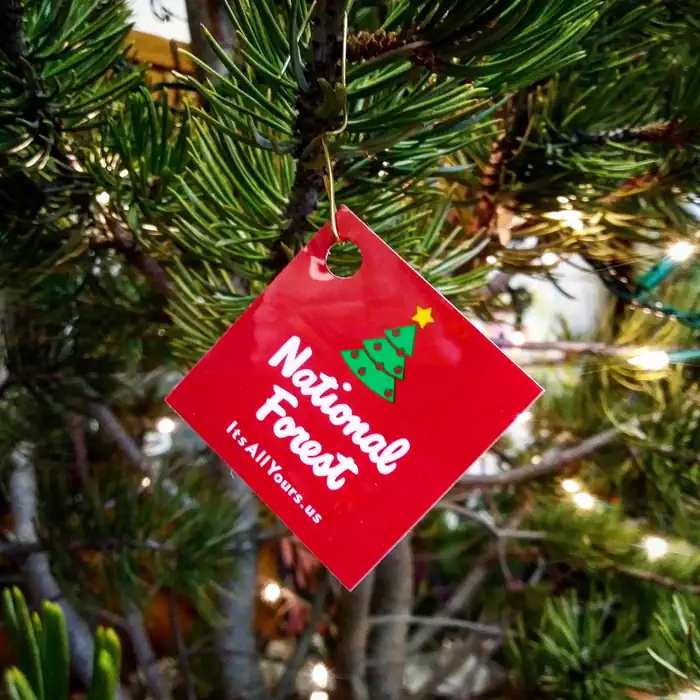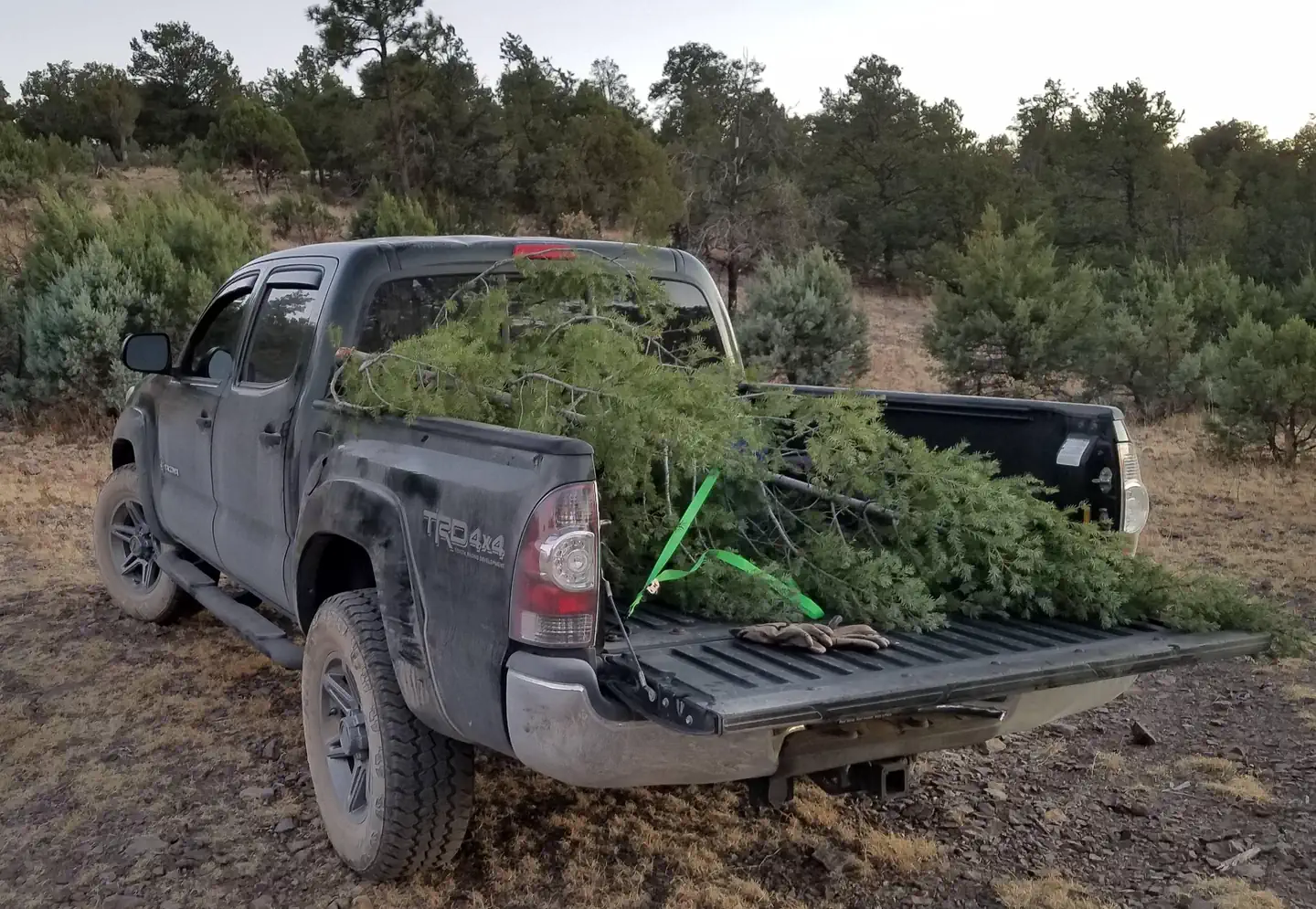Gila National Forest Christmas Tree Permit
This permit allows you to cut a Christmas Tree within designated areas of the Gila National Forest! Lifelong memories are built during these special times and we are happy to help with any information gathering you'll need to make this trip a safe and enjoyable one.
Please be sure to read and agree to all the tips and guidelines when selecting your tree.
Notifications and Alerts
The Gila National Forest Christmas Tree Permits will become available for purchase online Thursday, November 13 until online permits are sold out. Walk-in permits will be available for sale at all district offices Mon-Fri 8am - 4:30pm on November 24. Trees may be cut and removed with your issued permit beginning November 24, 2025.
Quemado Ranger District - #3 Lyle Loop, Quemado, NM 87829. (575) 773-4678
Reserve Ranger District - 5 Smokey Bear Circle, Reserve, NM 87830. (575) 533-6232
Silver City Ranger District - 3005 E. Camino del Bosque, Silver City, NM 88061. (575) 388-8201
Wilderness Ranger District - 3697 Hwy 35 N, Mimbres, NM 88049. (575) 536-2250
Black Range District - 1804 N. Date Street, Truth or Consequences, NM 87901. (575) 894-6678
Glenwood Ranger District - Hwy 180 S, 18 Ranger Station Rd., Glenwood, NM 88309. (575) 539-2481
Tips for success when headed to the forest:
Road conditions can be bad. Be prepared for mud and snow by carrying tire chains, tow chain and shovel. Always notify friends or relatives where you intend to go and expect to return.
Keep your vehicle on the road to prevent ruts and subsequent erosion.
Leave early enough to be back to the car before dark. Remember, it gets dark quite early this time of year.
Dress to protect yourself from wind, cold, and wetness.
For an extended hike, carry: maps, compass, whistle, knife, flashlight, matches, protective clothing, first aid kit, extra food and water.
Close all gates and, if you PACK-IT-IN be sure to PACK-IT-OUT!
Need to Know
Where to Cut Your Tree
Do not cut within wilderness areas, riparian (river and stream) areas, and areas within 200 feet of paved roads and developed recreation sites.
Do not cut in active timber sales or areas that have been planted with new trees.
Some Ranger Districts may have certain areas where Christmas Trees may be cut. Please check with the appropriate District Office where you will be cutting your Christmas tree.
Stay on roads open to motorized use on the Motorized Vehicle Use Maps that can be downloaded from this site.
Selecting Your Tree
Cut only one tree per tag.
Each forest has limitations on the size of the tree you can cut and the species of trees that are permitted. See below to help you measure and choose a tree that meets your permit's guidelines.
Tree Height: 10 feet maximum
Take the whole tree. Do not remove the top of the tree; cut down the entire tree
If snow is on the ground, remove it from around the stump so you can accurately measure the stump and tree height.
Select a tree with a trunk 6" or less in diameter. Cut stumps within 6" from the ground.
Boughs and branches trimmed from trees cut for Christmas trees may be taken for decorations. Do not cut branches from live trees.
Any limbs or portions of the tree left on the ground must be trimmed down to 12 inches (or lower in height) from the ground. This will provide a more pleasing appearance to the area and reduce the fire hazard through faster decomposition of the branches.
Planning Your Trip
How to Plan Your Trip
Before you leave home, be sure to measure the space where you plan to place the tree in your home (height and width), and measure the space in your vehicle where you will be transporting the tree.
You must print and bring your Christmas Tree Permit with you.
Cell service may be spotty or unavailable. Be sure someone knows where you are and when to expect you back.
Check the latest weather conditions, forest warnings and road closures before you leave on your trip.
Bring a map with you. Don’t rely on GPS because it may not be up-to-date with forest service roads.
Dress warmly and take extra dry clothes. Expect winter weather, including cold temperatures, snow and winds.
Roads may not be plowed. Carry tire chains, shovel(s) and a tow chain. Be sure your vehicle has a full tank of gas. Park in areas so that traffic can get by safely, and do not block gates. Bring a spare key and give it to someone else in your party. Don’t get locked out of your car!
Bring plenty of food and water with you as well as an overnight survival kit in case you become stranded.
Start your day early. Be sure to find your tree and leave the woods before dark.
Helpful Cutting Tips
Carry your tree carefully out of the woods. Dragging the tree will rub off needles and bark.
If the tree is too big to transport inside of your vehicle, wrap it in canvas to prevent wind damage.
Once home, cut the bottom of the trunk off and place the freshly cut trunk in a bucket of water. Replenish water.
If storing your tree outside for a few days before putting it in the house, keep it in an area protected from the wind, such as the north or east side of your house or under a shaded tree.
Tools you might want to consider bringing with you include a measuring tape to ensure you select a tree that fits in your home; handsaw to cut your tree; gloves to protect your hands; boots to protect your feet; a tarp to sit on and/or to move your tree once it's cut; and rope or straps to secure your tree to your vehicle.
Choose a tree from a dense forested area, which will give the remaining trees more space to grow.
Cut the leftover branches from the stump and scatter them.



